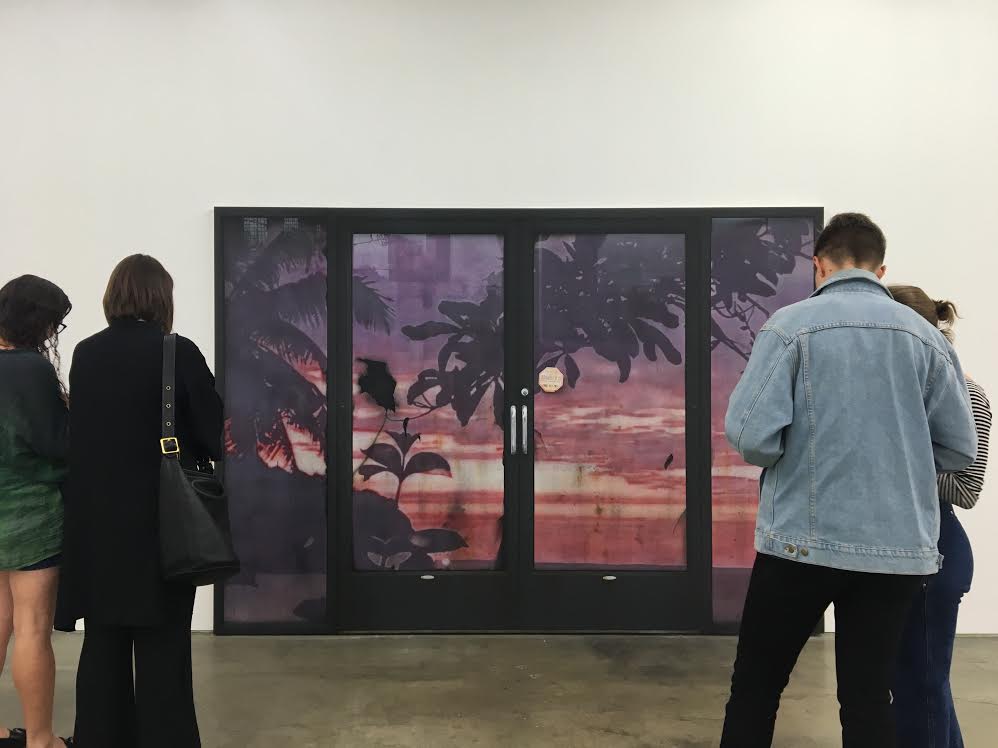Sayre Gomez’s ‘Déjà Vu’ explores psychological introspection
 Los Angeles-based artist Sayre Gomez’s second solo exhibit, Déjà Vu, is on view at Ghebaly Gallery until Nov. 18. The show is laid out like a maze, the rooms folding into each other with paintings playing on the perspective of the ones that preceded. The multimedia works range from short videos playing on a loop to illusionistic scenic paintings, the common thread between them lying in the theme of restraint.
Los Angeles-based artist Sayre Gomez’s second solo exhibit, Déjà Vu, is on view at Ghebaly Gallery until Nov. 18. The show is laid out like a maze, the rooms folding into each other with paintings playing on the perspective of the ones that preceded. The multimedia works range from short videos playing on a loop to illusionistic scenic paintings, the common thread between them lying in the theme of restraint.
Gomez’s Déjà Vu begins with a video loop of a scene from the 1941 Disney film Dumbo in which an angry gorilla shakes the bars of its animated prison. The show continues with a large acrylic painting of a set of double doors, shut closed and obscuring a backdrop of a pink-hued sunset. Following the piece is a series of acrylic works exploring the concept of focus; a fence overgrown with vines is portrayed clearly, whereas the background it is caging is faded to a point of nearly uncomfortable ambiguity. In one, several buildings comprise the background; in another, two women. Each harnesses the power to make the viewer feel trapped on the outside.
Another double-doored painting appears. This one features large disheveled pieces of paper, blocking any visual entry into the space. The reflective realism of the windows invites the viewer while the subject matter raises further questions as to the installation’s thematic statement. The next room offers several pieces that appear to be made of wood with stickers mounted on top of them, reminiscent of a child’s dresser. In a piece called “Dreamer,” a red mug and lit candlestick overlooks a gloomy backyard. With titles like “Bad Boy,” “World Won’t Listen” and “Good Boy,” the wood and sticker works further embody an adolescent angst, at once trapped in emotion and simultaneously trying to project that emotion onto the world around Gomez by utilizing surfaces readily available to him.

Los Angeles-based artist Sayre Gomez’s second solo exhibit ‘Déjà Vu’ will be on view at Ghebaly Gallery through Nov. 18. Natalie Pashaie | Daily Trojan
By experimenting with perspectives and confinement, Gomez is also commenting on distribution of power. This is accentuated by the painting of a fighter pilot who looks like a character pulled out of Star Wars — childlike within its own subject matter, the character also doubles as a figure of power. The straightforward portrait style establishes its dominance, as the viewer is directly confronted by the harsh figure, but it is starkly trapped within the frame. Thus, we become aware that we are free, and in this way, we are released back out into the world.
Restraint and captivity are themes repeated throughout the exhibition, whether that be through the stern, closed doors painted by Gomez or through the hyper-focused, magnified nature of the wood-and-sticker paintings. The show transitions with paintings of views from the outside world to views from the inside and, in doing so, establishes a journey of psychological introspection. The ambiguity of the artist’s scenic “outside” paintings is bound to offer the viewer a familiar view, but the haziness makes them cold, uncertain and consequently foreign.
